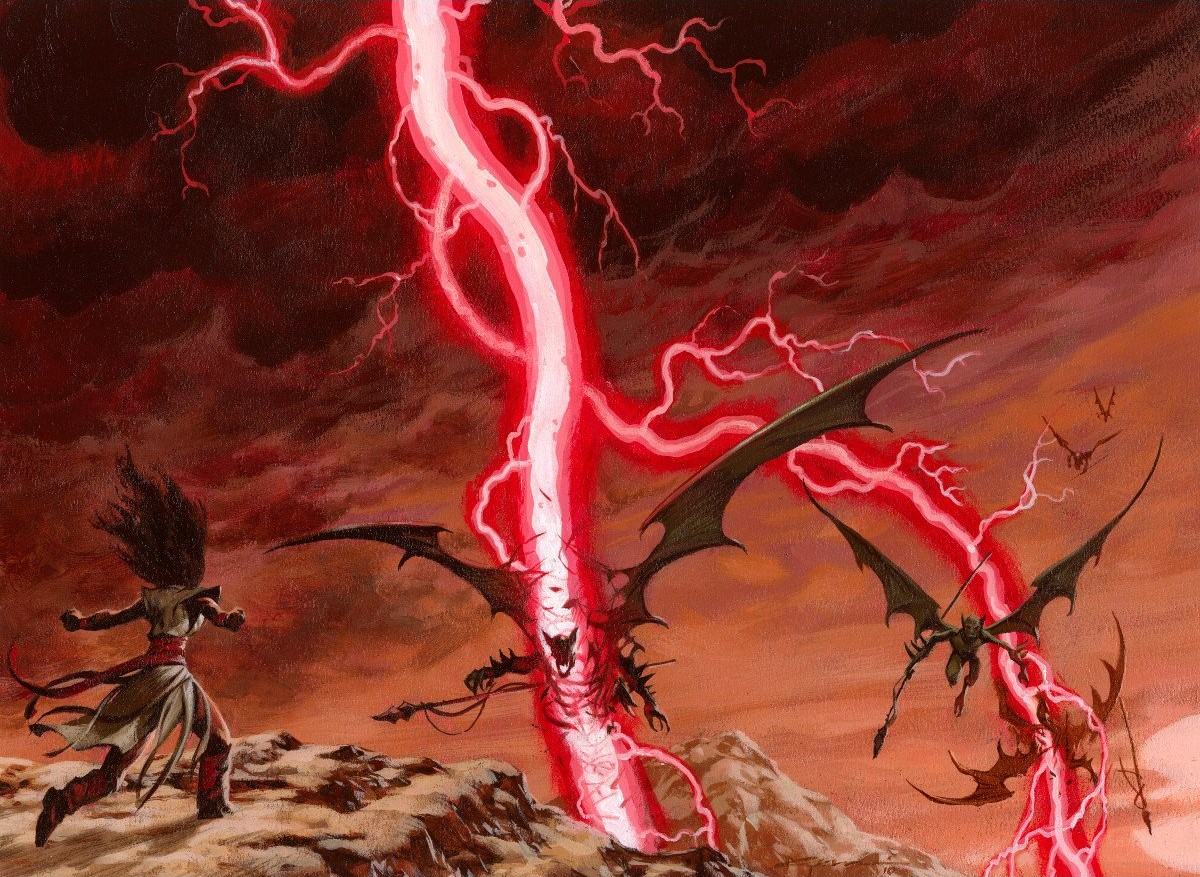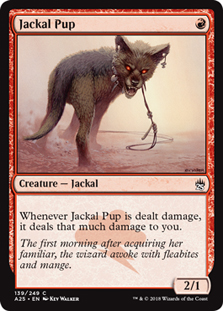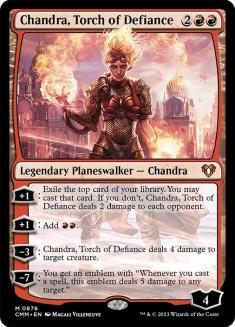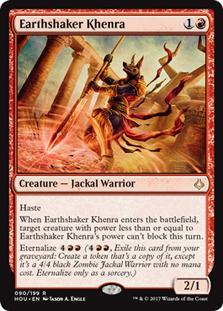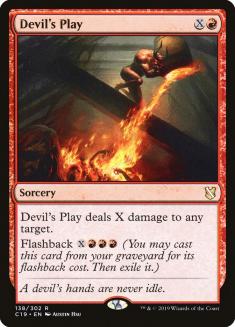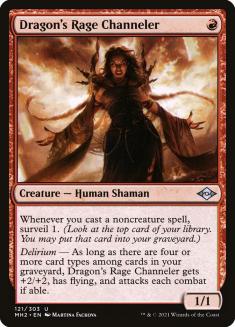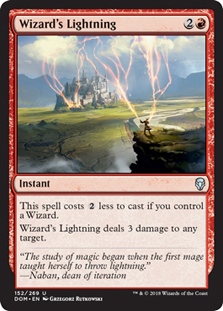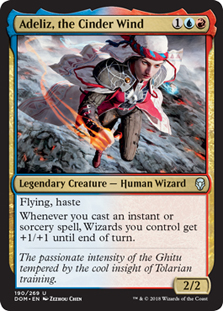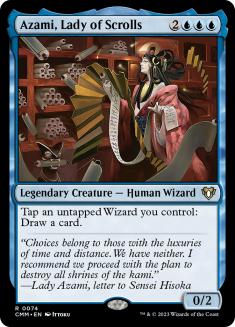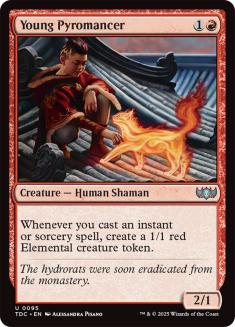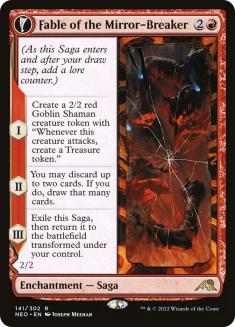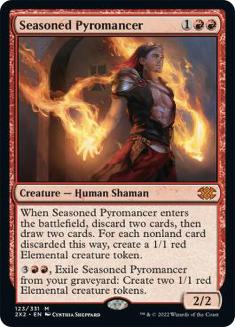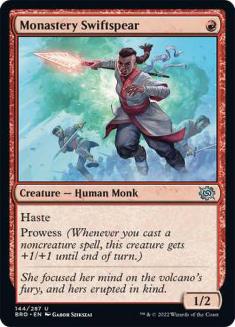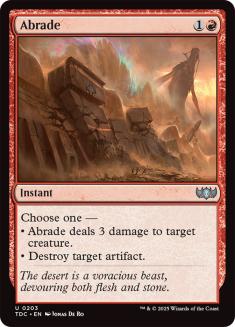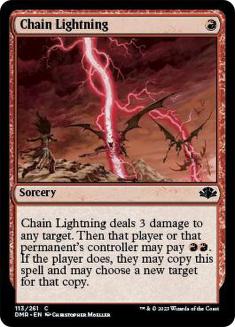Hello, and welcome to the halfway point on my series on the most Cubeable cards in Magic. Last week I went over black, which means that we’re on red this week.
A reminder to anybody who for whatever reason is jumping in on this series in the middle of it, these are my picks for the cards that best fit a wide range of Cubes and lead to good gameplay, and are explicitly not the most powerful cards in Magic.
Tuning Red
Red can be a tough color to balance in Cube. I see it commonly expressed that some groups just don’t have players who are all that interested in drafting and playing aggressive decks. The customer is always right in matters of taste, but there are ways to address this by changing the shape of your Cube’s red decks, too. I’ll be addressing this in several of today’s entries.
A major focus point for making red work in Cube should be limiting cards that are best in controlling or aggressive decks, and offering options that bridge between these two macro-archetypes. This will allow players to play midrange decks and pivot in one direction or another, and it will make the average red card far more appealing.
It also helps you sidestep the issue that players who don’t like playing and drafting aggressive decks miss the point that Goblin Guide isn’t remotely powerful enough to make an archetype tick, but that red aggressive decks get there on having a high volume of similar effects. A squad of Jackal Pups is a lot better to have around than a solitary Goblin Guide. Including threats on varying points on the curve that play in aggressive and controlling decks alike allows aggressive decks to get there on volume and offers players the agency to draft the sort of deck that they’ll enjoy playing.
Some of my picks will be more slanted towards aggressive decks, given that this is really what red has always been best at, but there’s definitely an emphasis on more than just attacking and blocking. Let’s get to the list!
10. Chandra, Torch of Defiance
Chandra, Torch of Defiance had a massive wow factor upon being previewed. With her four loyalty abilities, it was only natural for players to wonder if Chandra would be the next Jace, the Mind Sculptor. The answer, of course, was no, not even close, but Chandra is still pretty good! More of an upgraded Flametongue Kavu than anything, Chandra is still near the top of the list for powerful red four-drops in Cube.
For my money, I’d rather have a Hellrider or a Koth of the Hammer in an aggressive red deck, but what makes Chandra awesome is that the card plays in aggressive and controlling decks alike. You can draft Chandra highly with the intention of playing all Mountains or a multicolor midrange strategy.
Chandra will be a little much for very low-power Cubes, but has proven to be a balanced and engaging card for the Magic Online (MTGO) and Arena Cubes alike, with the damage-dealing ability costing too much loyalty for Chandra to take over many games unassisted. This is just one of those very playable cards that’s flashier than it is powerful, which makes it exciting and fun to feature in Cube.
9. Earthshaker Khenra
Primarily an aggressive card, Earthshaker Khenra has just enough kick to play in midrange decks. The card specifically offers good utility for attacking down planeswalkers, and it’s a nice one to discard to your Chart a Course or what-have-you to get back later.
Ultimately, Earthshaker Khenra will show up in more strictly aggressive decks than anything, but it has very high value over replacement in those decks relative to other two-mana creatures. Amonkhet-era Standard offers a lot of lessons on what makes aggressive ticks tick into the late-game, and mana sinks and two-for-ones are big parts of this equation. Red aggressive decks aren’t usually trying to make their sixth land drop, but what Earthshaker Khenra offers is a puncher’s chance at winning games when they have to. As an individual card, I have a lot more positive things to say about what Earthshaker Khenra adds to red decks than Goblin Guide.
8. Devil’s Play (or Assorted Fireballs)
While this entry is specifically about Devil’s Play, I find that having one Fireball-esque effect around adds a lot to how you can play and build red decks. In higher-power and higher-variance Cubes, you’ll see something like Bonfire of the Damned, and in my Pauper Cubes, you’ll find Rolling Thunder. Crater’s Claws and Light Up the Night are some other favorites of mine, and the list of options here is quite long.
What makes Devil’s Play special is, of course, the flashback ability. Sometimes you have to use your Blaze as an inefficient spot removal spell, and that just doesn’t feel very good. Getting a second shot at your game-ender, albeit at an increased cost, makes plays like that more satisfying. The Devil’s Play layup where you go upstairs and signal to the opponent that you intend to end the game with the flashback is another classic line that I can’t get enough of.
More than anything, these effects offer red decks late-game reach that the more abundant chip-shot damage spells just don’t. It’s very deflating to have a deck full of junk like Searing Spear when your opponent is at eight and you’re topdecking, but the drama that a variable damage spell adds to these games is well worth a slot in a great deal of Cubes.
7. Dragon’s Rage Channeler
Dragon’s Rage Channeler is more of an aggressive card than anything, but the card selection that the card offers and nod to delirium make it much more engaging than the average one-drop. I don’t actually find the card to be all that good in Vintage Cube, but once you lower the power level a bit and intend to play games that last a little longer, you really start to see the value of the card selection that Dragon’s Rage Channeler offers.
Dragon’s Rage Channeler naturally draws a drafter to cards like Lightning Bolt, but more than other red one-drops, it also draws you to cards like Ponder, Thoughtseize, and Mishra’s Bauble. It’s been one of my favorite recent additions to Spooky Cube, and the control that it can give you over your draw step and synergy with other graveyard-matters cards make it a very fun and flexible tool.
6. Grim Lavamancer
Grim Lavamancer has always been a Cube staple. The years haven’t necessarily been kind to the card, but with red aggressive decks primarily being concerned with volume, it can definitely still hang. The other significant part of the appeal is that Grim Lavamancer is a great tool against aggressive decks, with some Visara the Dreadful-esque qualities.
Being a Human that costs one matters for those interested in Cubing with Thalia’s Lieutenant and Xathrid Necromancer. I haven’t put together a Cube where Wizards matter myself, but there are quite a few cards worth exploring there as well.
Grim Lavamancer is good on rate, flexible in the role that it plays, and offers some positive externalities as well. What’s not to like?
5. Young Pyromancer
I actually don’t like Young Pyromancer as much as the next player. That’s because the card is incredibly popular and well-liked! As such, it’s really easy to justify including the card in a Cube, from Peasant to Vintage. Young Pyromancer facilitates spells-matters and sacrifice decks alike, and offers a nice bridge to hybridize these archetypes as well.
Young Pyromancer is much bigger value-add to aggressive decks than controlling ones, but it does play in both, which makes it a very nice card to Cube with. The high ceiling and low floor of a 2/1 that snowballs value makes Young Pyromancer feel like a powerful card to play with and a manageable one to play against.
4. Fable of the Mirror-Breaker (and Seasoned Pyromancer)
Fable of the Mirror-Breaker is pretty new to the scene, but it’s been showing up a ton in Constructed and is a very fun card to play with. What the card offers is similar enough to Seasoned Pyromancer that it only seems right to me to group them together, and both cards do a great job of fitting into aggressive and controlling decks alike.
Generating multiple bodies and offering some card selection is just more than you get from the typical red three-drop. These cards won’t offer as many runaway games as a card like Goblin Rabblemaster, but they’ll be appealing to more drafters at the table on average.
It’s worth noting that Fable of the Mirror-Breaker has a much higher ceiling than Seasoned Pyromancer, and that it actually opens up some combo potential. You won’t be able to go fully infinite with a Pestermite with Reflection of Kiki-Jiki, but you will be able to take all the turns with Eternal Witness and Time Warp. The bodies that Fable generates are just much more demanding of removal in general. In some ways, that makes the card more appealing because there’s more that you can do with it, but if you’re interested in keeping the power level of your Cube a little lower, then Seasoned Pyromancer is certainly the more modest choice.
3. Monastery Swiftspear
I’m not sure where Monastery Swiftspear would have landed on my list prior to its recent downshift to common, but with the card now being a powerful option for all Cubes from Pauper to Vintage, it’s just one you can expect to see quite a lot of. My love for prowess is no secret, and pairing Monastery Swiftspear with anything from Kessig Flamebreather to Fireblast brings me a lot of joy.
Monastery Swiftspear just gives red players options in combat that bozos like Goblin Guide with static power and toughness don’t. This makes blocking a stressful proposition, even with powerful anti-red cards like Courser of Kruphix, and opens up the possibility for bluffing.
Monastery Swiftspear is very similar to Soul-Scar Mage, so it seems worth pointing out why they’re not listed together. Swiftspear’s aforementioned downshift to common is certainly part of it, but beyond that, haste is a powerful keyword that makes Monastery Swiftspear among the best aggressive one-drops of all time for red decks. Soul-Scar Mage is more reliant on actually offering explicit prowess support, which I am a fan of, but that is a significant barrier for entry. As long as you care about attacking at all, it’s usually pretty easy to justify Swiftspear.
2. Abrade
One of my least favorite things to see in the red column of a Cube is multiple Incinerate effects. The gameplay of “oops all Lava Spikes” isn’t terribly engaging, these cards are pretty weak as removal, and paying two for the effect isn’t at all exciting. “Creature or planeswalker” damage effects similarly draw my ire, but Abrade is a masterpiece. Much like getting three damage for two mana, nobody is lining up to cast Shatter these days, but Abrade manages to make the choice between two medium deals exciting.
In a lot of Cube environments, certainly in most Vintage Cubes, your opponent will present either blockers or mana rocks. In any framework where this is true, Abrade is a godsend for red decks. Being able to destroy powerful Equipment also comes up in a wide range of Cubes that deviate from this framework as well.
I’ve been a huge fan of Bonecrusher Giant as a card to break free from the hold of Incinerate in Cube, but like many cards from Throne of Eldraine, the power level on that one can be backbreaking. Abrade is just a very honest rate that I’m happy to play in my red decks in any environment with a decent selection of artifacts.
1. Lightning Bolt (and Chain Lightning)
When Lighting Bolt isn’t in your Cube, all of your players will ask, “Where’s Lighting Bolt?” The most iconic red card ever printed, with apologies to Hurloon Minotaur, and possibly the most-cast spell in Magic, Lightning Bolt is what red is all about. At lower power levels, you can justify getting away from Lightning Bolt, but for my money, the positive associations of playing with Lightning Bolt are impossible to replace, and for most environments I don’t see it being worth the effort to try to get away from it.
If Lighting Bolt is the first card I’m adding to my red column, Chain Lightning is the second. Options in red fall off a cliff after this, and while it feels bad to play with Incinerate in 2022, it feels even worse when you draw a removal spell that can’t kill a three-toughness creature. I’ll also add Firebolt to almost any Cube that could include it, though the good spells that deal three are much less replaceable.
Leaving Out Lightning Bolt
If Lightning Bolt isn’t in a Cube, it will most commonly be for aesthetic or color-restricted reasons, like it not being in the set of a set Cube, or not in the colors of a Bant Cube. If you have a Cube group that is generally against drafting with Lightning Bolt, then I imagine your tastes are so particular that you’re not looking for advice from me or anyone else anyway. It is simply so iconic and at a generally accepted power level that its exclusion requires justification. There are definitely more reasons to shy away from Chain Lightning, but I’ll at least put it on the record that including both has always been positive for the gameplay of red decks in my experience.
And that rounds out red! I imagine that number one was pretty easy to call this week, but next week I’ll be tackling what I’ve found to be the most difficult individual color in the series. I’ll see you then for green.

